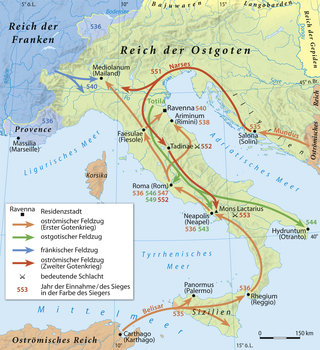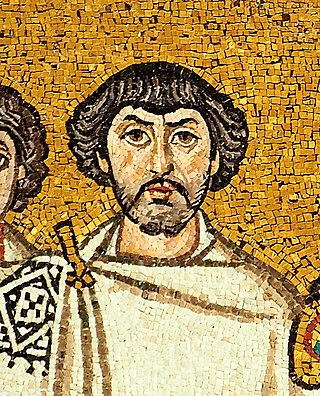Notes and references
Notes
- ↑ Famine is described as "T538.1, Failure of bread" in the Annals of Tigernach. [4]
Related Research Articles
The 530s decade ran from January 1, 530, to December 31, 539.
The 540s decade ran from January 1, 540, to December 31, 549.
The 550s decade ran from January 1, 550, to December 31, 559.
Year 536 was a leap year starting on Tuesday of the Julian calendar. At the time, it was known as the Year after the Consulship of Belisarius.

Year 537 (DXXXVII) was a common year starting on Thursday of the Julian calendar. At the time, it was known as the Second year after the Consulship of Belisarius. The denomination 537 for this year has been used since the early medieval period, when the Anno Domini calendar era became the prevalent method in Europe for naming years.

Narses was, with Belisarius, one of the great generals in the service of the Byzantine Emperor Justinian I during the Roman reconquest that took place during Justinian's reign. Narses was a Romanized Armenian. He spent most of his life as an important eunuch in the palace of the emperors in Constantinople.

The Gothic War between the Byzantine Empire during the reign of Emperor Justinian I and the Ostrogothic Kingdom of Italy took place from 535 to 554 in the Italian peninsula, Dalmatia, Sardinia, Sicily, and Corsica. It was one of the last of the many Gothic wars against the Roman Empire. The war had its roots in the ambition of the Byzantine emperor Justinian I to recover the provinces of the former Western Roman Empire, which the Romans had lost to invading barbarian tribes in the previous century, during the Migration Period.
The First Siege of Rome during the Gothic War lasted for a year and nine days, from 2 March 537 to 12 March 538. The city was besieged by the Ostrogothic army under their king Vitiges; the defending East Romans were commanded by Belisarius, one of the most famous and successful Roman generals. The siege was the first major encounter between the forces of the two opponents, and played a decisive role in the subsequent development of the war.
Sittas was a Byzantine military commander during the reign of Emperor Justinian I. During the Iberian War against the Sassanid Empire, Sittas was given command of forces in Armenia, similar to the status of Belisarius in Mesopotamia. He won a victory over the Sassanids at the battle of Satala.

Belisarius was a military commander of the Byzantine Empire under Emperor Justinian I. Belisarius was instrumental in the reconquest of much of the Mediterranean territory belonging to the former Western Roman Empire, which had been lost less than a century prior. He is considered one of the greatest military commanders in history and the greatest of all Byzantine generals.
Aratius was an Armenian military commander of the 6th century whose brother was Narses. He served at first the Sasanian Empire, then defected to the Byzantine Empire. He is primarily known for his activities in the Iberian War and the Gothic War. He was eventually killed in an ambush. Primary sources about him include Choricius of Gaza and Procopius of Caesarea.
Justin was a 6th-century East Roman (Byzantine) general, who was active in the Gothic War in Italy under Justinian I.

John, also known as John the Sanguinary, was the nephew of the rebel Vitalian and was an Eastern Roman general under Justinian I, who was active in the Gothic War in Italy and against the Gepids in the western Balkans. He was married to Justina, the daughter of Justinian's cousin Germanus.
Bessas was an Eastern Roman general of Gothic origin from Thrace, primarily known for his career in the wars of Justinian I. He distinguished himself against the Sassanid Persians in the Iberian War and under the command of Belisarius in the Gothic War, but after Belisarius' departure from Italy he failed to confront the resurgent Goths and was largely responsible for the loss of Rome in 546. Returning east in disgrace, despite his advanced age he was appointed as commander in the Lazic War. There he redeemed himself with the recapture of Petra, but his subsequent idleness led Justinian to dismiss him and exile him to Abasgia.
Vacis was an Ostrogothic commander under King Witigis during the Byzantine–Gothic War (535–554).
The siege of Ariminum, also known as the siege of Rimini, was an encounter in the Gothic War between Byzantine forces under Belisarius and John and an Ostrogothic force in 538 AD.
The siege of Urbinus also called siege of Urbino or siege of Urbinum took place in the year 538 during Justinian's Gothic War. Earlier, when John took Ariminum, he had bypassed Auximus and Urbinus which would have to be taken now to secure the road to Ravenna. The Gothic king, Witigis, had sent a man called Moras with 2.000 troops to defend the city. In the year 538, the Byzantine commander, Belisarius went to besiege the town while another strong Byzantine contingents besieged Urviventus. The forces of Narses and John, other Byzantine commanders, who were undermining Belisarius' authority, joined him in this venture. Thinking the defenders would be terrified on seeing the Byzantine army, Belisarius sent envoys offering the garrison a chance to surrender. Narses and John set up camp separately form Belisarius, on the other side of the town, and, after negotiations with the garrison failed, totally abandoned the siege. They declared taking the town impossible and moved to capture Aemilia but while Belisarius was preparing to assault the town surrendered due to the failure of its spring. Astonished by such success, Narses sent John to capture Caesena but this assault failed. John then moved to and managed to capture Forocornelius. After this siege Belisarius moved to support in the siege of Urviventus, also capturing that city shortly after.
The siege of Ravenna of 539-540 took place during Justinian’s Gothic War.
Narses was an Armenian military commander in service of the Sasanian Empire and later the Byzantine Empire.

Mauricius was a Gepid general fighting for the Byzantine Empire. He was the son of Magister militium Mundus. He was presumably an MVM vacans.
References
- ↑ Procopius, De Bello Gothico II
- ↑ Procopius, De Bello Gothico I.XIII
- ↑ Martindale, Jones & Morris 1992 , pp. 125, 255, 641
- ↑ Mac Niocaill 2010, pp. T538.1.
Secondary sources
- Mac Niocaill, Gearóid (2010). "The Annals of Tigernach". CELT: Corpus of Electronic Texts: a project of University College Cork, College Road, Cork, Ireland. Retrieved October 1, 2016.
- Martindale, John Robert; Jones, Arnold Hugh Martin; Morris, J., eds. (1992). The Prosopography of the Later Roman Empire, Volume III: A.D. 527–641. Cambridge, United Kingdom: Cambridge University Press. ISBN 978-0-521-20160-5.